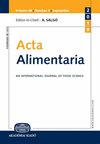Fibre and short-chain carbohydrate composition in rye varieties, novel industrial milling fractions and breads
IF 1
4区 农林科学
Q4 FOOD SCIENCE & TECHNOLOGY
引用次数: 0
Abstract
Rye is an important raw material of bread due to tradition and its favourable nutritional and technological qualities. Despite the beneficial fibre composition, a special group of short-chain carbohydrates, the so called FODMAPs (fermentable oligo-, di-, monosaccharides and polyols) may cause problems for patients with irritable bowel syndrome. The aim of our work was to investigate the non-starch carbohydrate (dietary fibre compounds, short-chain carbohydrates) composition of rye varieties, and of their novel milling fractions obtained from industrial milling trials and test loaves made from them. Regarding fibre and short chain carbohydrate composition, rye varieties did not show significant differences. In new subfractions, fibre and FODMAP composition were described, among profiles most of them differ from commonly used flours, independently from variety. The yeast fermentation and baking caused a decrease in water-extractable arabinoxylan content, at the same time increased the substitution pattern of water-extractable arabinoxylans. Furthermore, breadmaking process decreased the fructan content, and therefore increased the fructose level, thus modifying the short-chain carbohydrate composition. Based on our knowledge, this research is among the first ones investigating the fibre and short-chain composition of rye from the seeds to the consumable final products.黑麦品种、新型工业碾磨馏分和面包中的纤维和短链碳水化合物组成
黑麦因其优良的营养和工艺品质而成为面包的重要原料。尽管有益的纤维成分,一组特殊的短链碳水化合物,所谓的FODMAPs(可发酵的寡糖、二糖、单糖和多元醇)可能会给肠易激综合征患者带来问题。我们的工作目的是研究黑麦品种的非淀粉碳水化合物(膳食纤维化合物,短链碳水化合物)组成,以及从工业碾磨试验中获得的新型碾磨组分和由它们制成的测试面包。在纤维和短链碳水化合物组成方面,黑麦品种间差异不显著。在新的亚组分中,描述了纤维和FODMAP组成,其中大多数剖面不同于常用的面粉,独立于品种。酵母发酵和烘烤使水提阿拉伯木聚糖含量降低,同时增加了水提阿拉伯木聚糖的取代模式。此外,面包制作过程降低了果聚糖含量,从而增加了果糖含量,从而改变了短链碳水化合物的组成。据我们所知,这项研究是第一个研究黑麦从种子到最终消费产品的纤维和短链组成的研究。
本文章由计算机程序翻译,如有差异,请以英文原文为准。
求助全文
约1分钟内获得全文
求助全文
来源期刊

Acta Alimentaria
农林科学-食品科技
CiteScore
1.80
自引率
0.00%
发文量
47
审稿时长
18-36 weeks
期刊介绍:
Acta Alimentaria publishes original papers and reviews on food science (physics, physical chemistry, chemistry, analysis, biology, microbiology, enzymology, engineering, instrumentation, automation and economics of foods, food production and food technology, food quality, post-harvest treatments, food safety and nutrition).
 求助内容:
求助内容: 应助结果提醒方式:
应助结果提醒方式:


